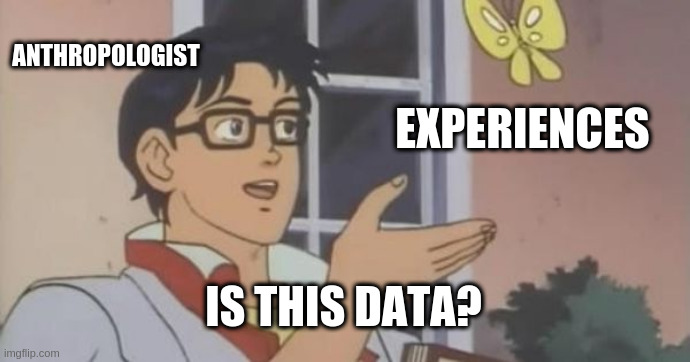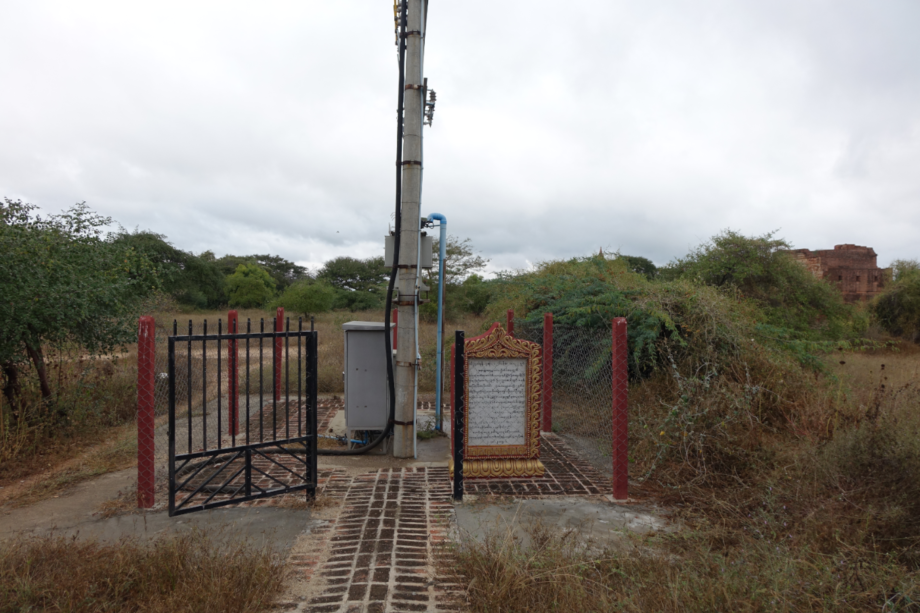When is Myanmar data?
The making of data through detachment and attachment
In the ongoing pandemic, news media daily confront their audiences with new case figures, ‘data’ in the form of diagrams and the numbers they are based upon. In this this blog post, I will illustrate how something similar has happened during my research with a freedom of expression focused organisation in Myanmar[1]. This will show the political effects of their use of ‘data’ as they anticipated it. I will go on to contrast their use with other uses of ‘data’, both by other Myanmar sources and my own. My aim is to critically examine how and when something becomes ‘data’.

An adaptation of the ‘Is this a pigeon?’ meme by imgflip, illustrating the search for the time and place of ‘data’.
Data for everyone to see
I was talking with Myint, a research coordinator of an organization focusing on the freedom of expression with which I was working for my research on digital rights activism in Myanmar. We had been talking about their research methodology for their reports. He told me that he anticipated they would not be prosecuted, either by a state actor or someone who felt defamed by what they proclaimed, for their reports themselves because they took care that they were “just reporting facts”. Through their efforts at detaching ‘data’ from the processes of its production, Myint anticipated that it would be more efficacious politically at a later stage since it would not be dismissed as partisan.
As Matthew Walton and colleagues (2015: 523) argued, politics in Myanmar is often interpreted as a morally dubious space where one can easily get entangled in interests which then taint one’s personal integrity and the credibility of one’s words and deeds. Further, being accused of defamation poses a risk because, while pre-publication state-censorship was officially ended in 2012, there exist six laws in Myanmar which ban defamation both online and offline. The most well-know is Article 66(d) of the 2013 Telecommunications Law (compare Spencer & Yin Yadanar Thein 2019).
Myint and his team relied on ‘daily media monitoring’ as well as interviews with experts and ‘concerned parties’ for their research. The organisations’ team of researchers gathered information from newspapers and online sources, corroborated with various sources, and documented cases which they identified as infringing upon freedom of expression. While they kept track of the documented cases in spread sheets, they then summarised them in their reports in two ways: They drew attention to specific legal cases through small case studies, and they added cases up and displayed the aggregates produced in that manner as diagrams. That way, they presented their research findings as ‘data’, held digitally, which could be counted and transformed into figures. By displaying the data as ‘facts’ rather than situated knowledge, they guarded themselves against the accusation of defamation.
Against this backdrop, their research methods allowed them to claim one of the kinds of detachment described by Thomas Yarrow and colleagues (2015): They sought to distance themselves from the strings that come attached to political and/or paid work. Yarrow and colleagues’ arguments are rooted in both the anthropology of ethics and in Marilyn Strathern’s works, which emphasises both relations and they ways in which they are cut (Yarrow et al. 2015: 22). Given Marilyn Strathern’s work on gifts (e.g. Strathern 1988) and the etymological connection between Marcel Mauss’ (2015) don and data in the Latin dare, it is interesting to note that, in this instance, data seems almost antithetical to gifts: What animates ‘data’ as presented in the above mentioned reports, what allows it to speak for itself, is its supposed detachment. It is not supposed to carry part of those who assembled it and only partly of those who gave the data to them. Because it is free, like free gifts (compare Parry 1986; Laidlaw 2000), Myint’s digital data can speak freely to issues that could otherwise be deemed defaming. Like parrhesia (Foucault 2001), it was free for its supposed lack of attachments. This does not make the organisations’ researchers parrhesiastes (compare Howe 2019), however, since they potentially do care for the consequences of what they proclaim. but those who pronounce it are not necessarily free from those concerns[2].
To summarise, I take it that Myint was not arguing that his organization’s activities are detached from politics at every stage of work but that, through their methods, they are actively detaching it from its potentially partisan origins. They did this to guard themselves against defamation, one political consequence, and to further their cause of legal reform, another political consequence. As detached data, for everyone to see, Myint anticipated its efficacy.
Background data
“Participants saw privacy not in the western notion of individual data but understood it instead as the protection of one’s own secrets within social groups.”
(Thant Sin Oo 2019: 33)
While the above description of my interlocutor’s ‘data’ production hinges on the efficacy of its claim to facticity, there is more to Myanmar data. As Thant Sin Oo and his colleagues (2019) found in their Digital Culture report, Myint’s notion of ‘data’ is not only one in Myanmar. Writing about images, messages, apps and other stuff held on their study participants’ phones, Thant Sin Oo describes the conversations the research team had with their interlocutors as revolving around secrets. For the purpose of this blog post, this illustrates three things: Firstly, ‘data’ is relevant beyond strict research contexts. It is also identified with the stuff people have on their phones. Secondly, ‘data’ is a matter of sharing and therefore potentially about giving.
Further, there is a doubling of ‘data’ in both Myint’s and Thant Sin Oo’s case: there is ‘data’ in the foreground, for everyone to see, and ‘data’ in the background, hidden from sight. In the case of Myint’s research team, much of the ‘data’ kept in their spreadsheets receded into the background in the reports. In Thant Sin Oo’s (2019) report, as he describes “individual data”, his own material is not foregrounded as ‘data’. The above shows that some things that could be (turned into) data remain hidden in the background as not all gathered data is shared and gathering is partial. In some instances, hidden data is the infrastructure for other work, as the spreadsheets are the infrastructure for Myint’s reports or like a cell tower is infrastructure for the mobile data connection of smartphones .

Cell tower in Bagan, central Myanmar. Credit: author.
In anonymising my own material, I too keep things out of sight which could be ‘data’. Further, since my research has been interrupted due to the Corona pandemic, much of what my interlocutors do now remains hidden from me. Previously, we shared documents on cloud storage, worked with data together, and were potentially subjected to data gathering ourselves, by cloud storage operators, for instance. While my digital(ized) data, fieldnotes I keep on transcribing into digital form, allow me to refer back to those collaborations, they have receded into the traces they left in my research recollections. Yet, my continuing work with my material as digital data is at least as dependent on my interlocutors as on my digital devices.
Given this reliance on personal connections for anthropological and other digital data gathering can what I as an anthropologist am dealing with even be called ‘data’, in the sense of something pre-given? Data has rightly been critiqued for the colonialist undertones of its epistemology and the tendency to think of it in terms of alienable property (Strathern 1999: 4). The metaphor has its limits as what is called data also “always has theoretical enframings that are its condition of making”, as Tom Boellstorf (2013) put it while Lisa Gitelman and Virginia Jackson have cautioned that ‘raw data’ is an oxymoron (Gitelman & Jackson 2013: 2). More recently, Annette Markham has argued that ‘data’ is a trap because its usage makes people believe the answers lie in the data itself, not in its interpretation (Markham 2018). Therefore, I occasionally insist to my supervisor that I do not have data in the sense of singular material units of information that I can evaluate independent of the evolving questions I have been asking. However, a documentation of its use allows me to draw (dis)connections.
At present, being detached from my research in Myanmar, how does data, my interlocutors’ and mine, live on? My collaborations on documents are currently not as vivid as they had been at the beginning of the pandemic. While I hope that our collaborations will gain new lives, I am left wondering when the photos of food cooked while in lock-down, the cascades of stickers in a messenger and the images my interlocutors post on Instagram will become data, when or if I will find a question that they serve as evidence for.
Written on 5 October 2020, revised 11 October 2020.
Benedict Mette-Starke is pursuing his PhD in socio-cultural anthropology at the University of Konstanz on digital rights activism in Myanmar. He is examining the infrastructures that activism relies on and those it addresses. His interests include activist knowledge practices as well as anthropological examinations of techniques. He can be contacted by email under benedict.mette-starke[at]uni-konstanz.de
Footnotes
[1] I consciously use Myanmar an adjective and a noun simultaneously to address both the questions of when ‘data’ is in Myanmar, i.e. how the word ‘data’ is used there and when stuff (Markham 2018: 521n7) in Myanmar, the country, become ‘data’, e.g. for me as an anthropologist.
[2] Therefore, it might be helpful to think obligation and freedom alongside each other.
References
Boellstorff, Tom. 2013. Making Big Data, in Theory. In: First Monday 18 (10). [doi:10.5210/fm.v18i10.4869]
Foucault, Michel. (1985) 2001. Fearless Speech. Los Angeles, CA: Semiotext(e) .
Gitelman, Lisa & Virginia Jackson. 2013. Introduction. In: Gitelman, Lisa (ed.). “Raw Data” is an Oxymoron. Cambridge (MA): MIT Press, 1-14.
Howe, Cymene. 2019. Greater Goods: Ethics, Energy, and Other-than-Human Speech. In: Journal of the Royal Anthropological Institute 25 (S1), 160–76. [doi:10.1111/1467-9655.13020]
Laidlaw, James. 2000. A Free Gift Makes No Friends. In: Journal of the Royal Anthropological Institute 6 (4), 617–34. [doi:10.1111/1467-9655.00036]
Markham, Annette N. 2018. Troubling the Concept of Data in Qualitative Digital Research. In: Flick, Uwe (ed.). The SAGE Handbook of Qualitative Data Collection. London: SAGE, 511-23. [doi:10.4135/9781526416070.n33]
Mauss, Marcel. 2015. The Gift. Expanded Edition. Translated by Jane I. Guyer. Chicago (IL): HAU Books.
Parry, Jonathan. 1986. The Gift, the Indian Gift and the “Indian Gift”. In: Man 21 (3), 453–73. [doi:10.2307/2803096]
Spencer, Oliver & Yin Yadanar Thein. 2019. It’s Time to Get Rid of Criminal Defamation. https://frontiermyanmar.net/en/its-time-to-get-rid-of-criminal-defamation. Last access: 05/10/2020.
Strathern, Marilyn. 1988. The Gender of the Gift: Problems with Women and Problems with Society in Melanesia. Berkeley: University of California Press.
———. 1999. Property, Substance and Effect: Anthropological Essays on Persons and Things. London: Athlone Press.
Thant Sin Oo. 2019. ‘Exploring Digital & Mobile Cultures in Myanmar’. https://www.digitalculturesmm.com/download.html. Last access: 11/10/2020.
Walton, Matthew J., Melyn McKay & Daw Khin Mar Mar Kyi. 2015. Women and Myanmar’s “Religious Protection Laws”. In: The Review of Faith & International Affairs 13 (4), 36–49. [doi:10.1080/15570274.2015.1104975]
Yarrow, Thomas, Matei Candea, Catherine Trundle & Joanna Cook (eds.). 2015. Detachment: Essays on the Limits of Relational Thinking. Manchester: Manchester University Press.































